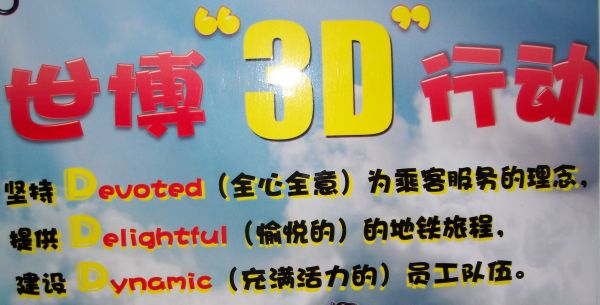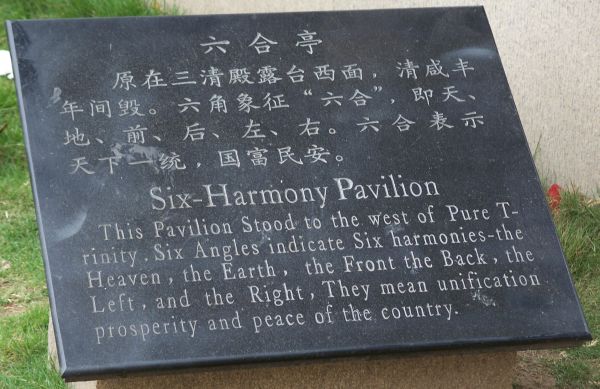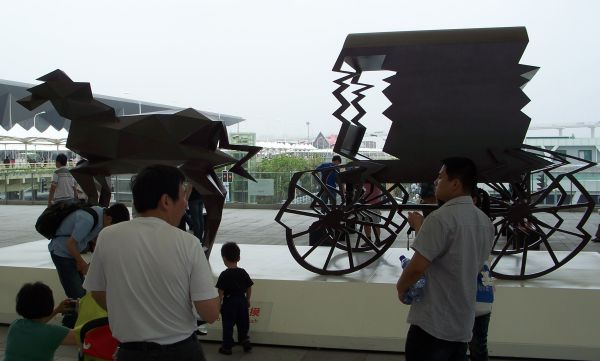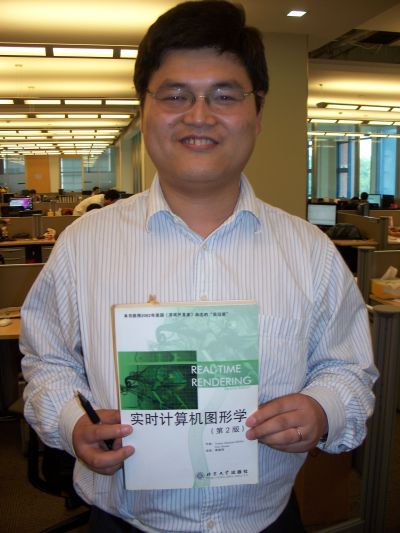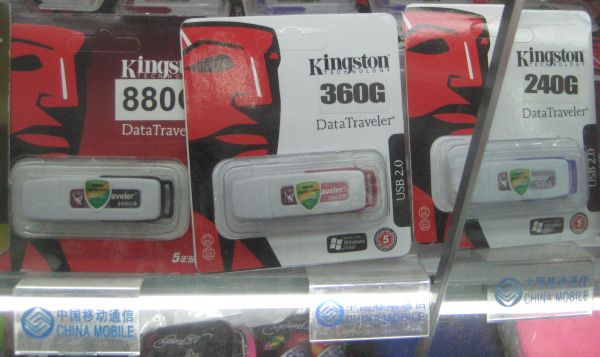I attended this year’s Gamefest back in February. Gamefest is a conference run by Microsoft, focusing on games development for Microsoft platforms (Xbox 360 and Windows). This year (unusually, due to the presence of prerelease information on Kinect, at the time still known as “Project Natal”) the conference was only open to registered platform developers. For this reason, I didn’t blog about it at the time (no sense in telling people about stuff they can’t see).
Recently (thanks to the Legalize Adulthood! blog) I became aware that the Gamefest 2010 presentations are online on the conference website, and available for anyone (not just registered XBox 360 and Windows Live developers). I’ll briefly discuss which presentations I think are of most interest. First, the ones I attended and found interesting:
This was a very nice talk about baking lighting into volumes by John O’Rorke, Director of Technology at Monolith Productions. Monolith were trying to light a large city at night, where the character could traverse the city pretty freely both horizontally and vertically. Lots of instances and geometry Levels-of-Detail (LODs), lots of dynamic lights. A standard lightmap + light probe solution took up too much memory given the large surface area, and Monolith didn’t like the slow baking workflow involved, as well as the inconsistencies between static and dynamic objects.
Instead, Monolith stored light probes in volume textures. They tried spherical harmonics (SH) and didn’t like it (too much memory, too blurry to use for specular). F.E.A.R. 2 shipped with an approach similar to Valve’s “Ambient Cube” (6 RGB coefficients), which has the advantage of cheap shader evaluation. For their new game they went with a stripped-down version of this, which had a single RGB color and 6 luminance coefficients; this reduces from 18 to 9 scalars and it was hard to tell the difference. Besides memory, this also sped up the shaders (less cache misses) and gave them better precision (since the luminance and color can be combined in a way that increases precision). For HDR they used a scale value for each volume (the game had multiple volumes in it) – this also gave them good precision in dark areas. Evaluating the “luminance cube” is extremely cheap (details in the slides). John also described some implementation details to do with stenciling out areas of the screen, using MIP maps, and getting around 360 alignment issues with DXT1 textures (all volumes were stored as DXT1).
Generation: the artists place lights (including area lights) and all the lights are baked (direct only, no global illumination (GI) bounces) during level packing. The math is simple – the tools just evaluated diffuse lighting for 6 normal directions at the center of each volume texel. Once the number of lights added by the artists started getting large this slowed down a bit so they added a caching system for the baked volumes. They eventually added GI support by rendering cube map probes in the game.
Downsides: low resolution, bad for high contrast shadows, can get light or shadow bleeding through thin geometry. They use dynamic lights for high contrast / shadow casting lighting.
For the future they plan to cascade the volumes and stream them. They also tried raymarching against the volume to get atmospheric effects, this was fast enough on high-end PCs but not consoles.
This great talk (by Stephen Hill from Ubisoft) went into detail on two rendering systems used in the game Splinter Cell: Conviction. The first was a software hierarchical Z-Buffer occlusion system. They used this in various ways to cull draw calls from shadows as well as primary rendering. The system could handle over occlusion 20,000 queries in around 1/2 millisecond. Results looked pretty good.
Next, Stephen discussed is the game’s ambient occlusion (AO) system. The game developers didn’t use screen-space ambient occlusion (SSAO), since they didn’t like the inaccuracy, cost, and lack of artist control. Instead they went for a hybrid baked system. Over background surfaces (buildings, etc.) they bake precomputed AO maps. The precomputation is GPU-accelerated, based on the GPU Gems 2 article “High-Quality Global Illumination Rendering Using Rasterization” (available here: http://http.developer.nvidia.com/GPUGems2/gpugems2_chapter38.html). For dynamic rigid objects like tables, chairs, vehicles, etc. they precompute AO volumes (16x16x16 or so). Finally for characters, they analytically compute AO from an articulating model of “capsules” (two half-spheres connected by a cylinder). Ubisoft combine all of these (not trying to address double-occlusion, so results are slightly too dark) into a downsampled offscreen buffer. Rather than simple scalar AO, all this stuff uses a directional 4-number AO representation (essentially linear SH) so that they can later apply high-res normal maps to it when the offscreen buffer is applied. They figured out a clever way to map the math so that they can use blending hardware to combine these directional AOs into the offscreen buffer in a way that makes sense. The AO buffer is later applied using cross-bilateral upscaling. For the future Ubisoft would like to add streaming support for the AO maps and volumes to allow for higher resolution.
Stephen showed the end result, and it looked pretty good with a character running through a crowded scene, vaulting over tables, knocking down chairs, with nice ambient occlusion effects whenever any two objects were close. A system like this is definitely worth considering as an alternative to SSAO.
This excellent talk (by Wade Brainerd, who like me works in Activision‘s Studio Central group) dives deep into a low-level description of Xbox 360 internals and the modified version of DirectX that it uses. A rare opportunity for people without registered console developer accounts to look at this stuff, which is relevant to PC developers as well since it shows you what happens under the driver’s hood.
This talk by NVIDIA contained basically the same stuff as the I3D paper Interactive Fluid-Particle Simulation using Translating Eulerian Grids, which can be found here: http://www.jcohen.name/. It was interesting to hear about such a high-end CUDA fluid sim system being integrated into a shipping game (even if only on the PC version) – they got some cool particle effects out of it with turbulence etc. These kinds of effects will probably become more common once a new generation of console hardware arrives.
This talk was about various ways to use DX11 Compute Shaders in graphics. This talk included stuff like fast computation of summed area tables for fast anisotropic blurring of environment maps and depth of field. The speakers also showed an A-buffer-like technique for order-independent transparency, and a tile-based deferred rendering system that was more efficient than using pixel shaders. Like the previous talk, this seemed like the kind of stuff that could become mainstream in the next console generation.
This presentation discussed research published in the SIGGRAPH Asia 2009 paper “All-Frequency Rendering of Dynamic, Spatially-Varying Reflectance“ (available here: http://research.microsoft.com/en-us/um/people/johnsny/). The presentation was by John Snyder, one of the paper authors. It’s similar to some other recent papers which represent normal distribution functions as a sum of Gaussians and filter them, but this paper does some interesting things with regards to supporting environment maps and transforming from half-angle to view space. Worth a read for people looking at specular shader stuff.
This talk was probably old hat to anyone with significant 360 experience but should be interesting to anyone who does not fit that description – it was a rare public discussion of low-level console details.
This talk was about combining physics with canned animation (similar to some of NaturalMotion‘s tools). It looked pretty good. The basic idea is straightforward – artist paints tightness of springs connecting the character’s joints to the skeleton playing the animation – a state machine allows to vary these tightness values based on animation and gameplay events.
This was a good, basic introduction to the current state of the art in shadow mapping.
Illuminate Labs (the makers of Beast and Turtle) gave this talk about baked lighting. It was pretty basic for anyone who’s done work in this area but might be good to brush up with for people who aren’t familiar with the latest practice.
Other Talks
There were a bunch of talks I didn’t attend (too many overlapping sessions!) but which look promising based on title, speaker list, or both: Case Studies in VMX128 Optimization, Best Practices for DirectX 11 Development, DirectX 11 DirectCompute: A Teraflop for Everyone, DirectX 11 Technology Update, and Think DirectX 11 Tessellation! – What Are Your Options?
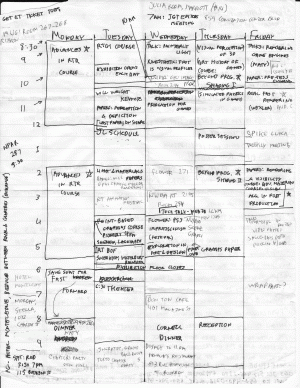 I’ve messed around with various scheduling methods over the years for SIGGRAPH, but find I dislike the form factor of PDA-like devices: you can see a few hours, or maybe a day’s activities at best. Taking notes can be tiresome, you need lots of clicks needed to find stuff, and sometimes the battery dies.
I’ve messed around with various scheduling methods over the years for SIGGRAPH, but find I dislike the form factor of PDA-like devices: you can see a few hours, or maybe a day’s activities at best. Taking notes can be tiresome, you need lots of clicks needed to find stuff, and sometimes the battery dies.